More than 40 years ago, the world’s first space station—Salyut 1, a “salute” to Yuri Gagarin, the first man in space —was launched into orbit by the Soviet Union. In April 1971, it was visited by Soyuz 10, but a fault with the docking prevented the three cosmonauts from entering the station. Following corrective actions, the Soviets planned to fly two further missions to Salyut 1, the first of which (Soyuz 11) would be commanded by the world’s first spacewalker, Alexei Leonov. However, an unfortunate series of incidents would conspire to frustrate Leonov’s mission … and brought tragedy to the men who flew in his place.
– Below, launch of the Salyut 1 space station atop a Proton rocket.
[cleveryoutube video=”PjWo1nmKHXg” vidstyle=”1″ pic=”” afterpic=”” width=”” quality=”inherit” starttime=”” endtime=”” caption=”” showexpander=”off” alignment=”left” newser=””]
The Original Crew
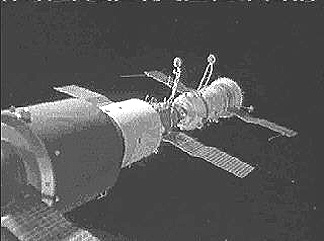
Photo of Salyut 1 with docked Soyuz 10 spacecraft, taken from TsKBEM photographer satellite. – Credits: TsKBEM.
The original plan after the Soyuz 10 failure was to fly Leonov and his Soyuz 11 crew, Valeri Kubasov and Pyotr Kolodin, on 4 June 1971, followed by another crew, consisting of Georgi Dobrovolski, Vladislav Volkov, and Viktor Patsayev, aboard Soyuz 12 on 18 July. Both missions would spend between a month and six weeks aboard Salyut 1, although it remained unclear if consumables aboard the station could support both teams until August. The Soviets decided that the length of Dobrovolski’s flight would therefore be dependent upon the success of Leonov’s mission. Then, on 3 June, shortly before Soyuz 11 was due to fly, all these plans fell apart.
Doctors from the Institute for Biomedical Problems in Moscow found a swelling on Kubasov’s right lung. It was a dark spot, about the size of a chicken egg … but it was sufficient for the entire Soyuz 11 crew to be grounded, as per Soviet crewing policy, and replaced by Dobrovolski, Volkov, and Patsayev. It was feared that the swelling might indicate the early stages of tuberculosis, but it was a misdiagnosis. As Leonov wrote in his memoir, Two Sides of the Moon, Kubasov was actually allergic to a chemical insecticide used on trees and soon recovered. The Soyuz 11 crew was already at the Baikonur launch site; had they not been, Kubasov might have simply been replaced with his backup, and Leonov and Kolodin would have still flown. However, flight rules stressed that “carrying out the replacement of the individual at the cosmodrome is not possible” and that “in case of such a necessity, it is only possible to carry out the replacement of the crew … ”
It was a devastating judgement, coming so soon ahead of launch. Leonov and Kolodin were furious and argued their case, but to no avail. Chief Designer Vasili Mishin told them that they may have drunk from the same cup as Kubasov and might also be affected, whilst the cosmonauts’ commander, Nikolai Kamanin, added to Leonov that arguing about it was not “reacting in the correct manner” to a decision which had already been made. Kolodin, it is said, returned to the hotel at Baikonur and got himself heavily drunk on vodka, crying with rage and frustration at his lost chance to fly into space.
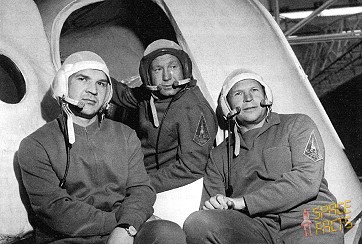
The original Soyuz 11—from the left, Valeri Kubasov, Alexei Leonov, and Pyotr Kolodin—were grounded shortly before launch by an unfortunate medical misdiagnosis. – Credits: Roscosmos.
Catching Up With Mission Preparation
For the replacement crew of Dobrovolski, Volkov, and Patsayev, it was not a moment of euphoria, for they had been training barely four months … and would be required to fly into space in a matter of days. Only Volkov had flown before, and he had no docking experience. A strong sense of foreboding permeated Baikonur in those final days. “If you look at photographs of the replacement crew, just before the launch,” Leonov wrote, “they even look a little scared.” Late on the evening of 3 June, before the doctors’ decision had been made, Leonov did a pencil sketch of Patsayev and later named it Patsayev’s Eyes, because the civilian engineer looked distinctly troubled. At some point that evening, he even approached Leonov to apologize for taking his place on the mission.
By now, the Soyuz 11 launch had been delayed until 6 June, and the six cosmonauts—Leonov’s grounded team and Dobrovolski’s men—sat, stone-faced, before a State Commission as Kamanin introduced them. Journalist Mikhail Rebrov noted that there was an intense silence in the room. Yet, in a roundabout sort of way, Leonov and Kubasov achieved a measure of revenge upon their superiors. When told by Kamanin to take a traditional walk with the prime crew in homage to their predecessors, both men refused … not out of bitterness for Dobrovolski, but out of bitterness against what had been an ill-judged decision. “If I am healthy, then I must fly,” Kubasov told Kamanin, indignantly. “If I am sick, I should not be there!”
Life Onboard Salyut 1
The sense of foreboding seemed to have disappeared by launch morning, and Dobrovolski, Volkov, and Patsayev smiled and waved their caps at the crowds before boarding the elevator at the pad. At 7:55 a.m. Moscow Time, they lifted off and arrived, without incident, at Salyut 1 the next day, 7 June. When the first television images of the three cosmonauts inside the station were displayed in the control center, the room erupted in applause. A stay of around three weeks, producing a landing on 30 June, was now likely. In those three weeks, the cosmonauts performed scientific experiments, exercised, took medical data, performed astronomical observations … and, on the 16th, endured a small fire aboard Salyut 1.
It was Volkov who noticed it first: an odor of smoke coming from the aft end of the space station. The Soviets’ insistence upon ridiculous secrecy meant that he had to employ a code word over the radio—“Aboard the station,” he said, cryptically, “is the curtain”—with curtain being the code for fire or smoke. Ironically, the ground controllers had forgotten what curtain meant and asked Volkov to repeat what he had said … to which the excitable cosmonaut blurted out, “There is a fire on board!” Although it later became clear that the “dense black smoke” had come from an overheating instrument, and was soon brought under control, it underlined the seriousness and risk of fire aboard a space station.
In the days that followed, the records rolled in, as the cosmonauts spent longer in orbit than anyone before them. On 18 June, Patsayev became the first spacefarer to celebrate a birthday in orbit. Little did he realize that his 38th birthday would actually be his last.
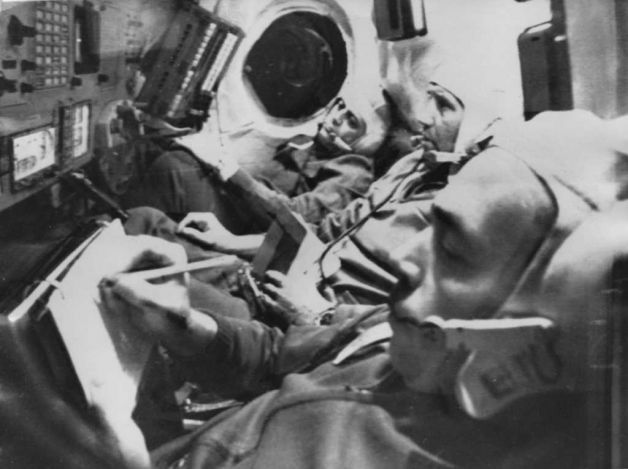
Another picture of the Soyuz 11 crew during onboard the Salyut 1 space station. – Credits: Roscosmos.
Heading Home
On the evening of the 29th, the three men departed Salyut 1 for the final time and took their places in the Soyuz 11 descent module for their return to Earth. Dobrovolski closed the hatch and sealed it by means of a rotating grip. However, he was surprised, and then alarmed, to notice that the “hatch-open” indicator on his panel remained lit. This told him that the hatch was not hermetically sealed, posing the risk of a pressure leak during re-entry and—since none of them had been provided with space suits—the death of the crew.
It was fellow cosmonaut Alexei Yeliseyev’s calm voice from the Yevpatoria control center in the Crimea which solved the problem. He talked Dobrovolski and Volkov through the procedure: reopen the hatch and turn the grip fully to the left, swipe the hatchway with a tissue to ensure that no foreign debris had blocked it, then close the hatch and turn the grip several times to the right. The two men tried this several times, but to no avail; the indicator remained illuminated. Further troubleshooting eventually isolated the cause of the fault. “As the hatch closes,” Yeliseyev recalled later, “it pushes the sensors and they produce signals. All the sensors were in working order, but the guys found that the hatch hardly touched one of the buttons, with the result that it did not push down sufficiently to send the signal.” After visually checking that the hatch was, in fact, closing tightly and correctly, Dobrovolski was told to stick a bit of insulation tape over the sensor to “generate the signal artificially.” When the crew tried again, the indicator blinked off, much to the relief of all concerned.
Minutes later, at 9:25 p.m. Moscow Time, the separation commands were initiated and Soyuz 11 successfully undocked from the station. When one considers the nightmare that was to follow in the next few hours, it is remarkable that no further sense of tension was noticeable in the cosmonauts’ words. As far as Dobrovolski’s crew was aware, a perfectly nominal return to Earth lay ahead of them. A long, challenging, and successful space mission was finally coming to an end, and they would soon be able to see and touch and speak to their loved ones again. The strain was gone from Volkov’s voice, as he joyfully announced the undocking and the stunning view of the world’s first space station drifting away into the inky blackness.
They would be the last humans ever to see Salyut 1 up close.
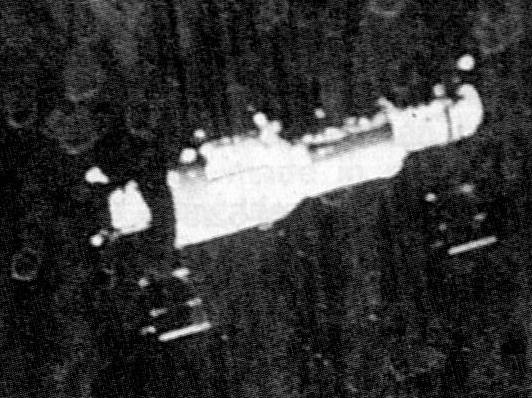
Grainy image from the departing Soyuz 11 mission in June 1971, showing Salyut 1. This was one of the last close-up views of the world’s first space station. Credits: Roscosmos.
Minutes To Disaster
Shortly after one in the morning on 30 June, three hours since undocking and flying serenely above the Pacific Ocean, close to Chile, Dobrovolski and Volkov oriented Soyuz 11 such that its main engine was facing into the direction of travel. The last words to or from the spacecraft have been debated over the years—officially, Nikolai Kamanin spoke to them at around 12:16 a.m. and a controller signed off with wishes of good luck for a soft landing, though space historian Peter Smolders suggested later in 1971 that Dobrovolski did make one final call to confirm that he was “beginning the descent procedure.” Adding more confusion was Alexei Yeliseyev himself, who recorded that Volkov jokingly asked for flight controllers to “prepare cognac”—a traditional welcome-home gift—and signed off with “See you tomorrow!”
In order to provide maximum visibility at the landing site, Soyuz 11’s retrofire occurred on its third orbit after undocking from Salyut. The engine fired for 187 seconds, as planned, beginning at 1:35 a.m., after which the orbital and instrument modules were jettisoned and the descent module maneuvered into the correct orientation for the fiery plunge back to Earth. The disaster that would engulf the three men must have unfolded rapidly and with scarcely any warning, for in his diary entry for that day, 30 June, Kamanin noted that no progress reports on either retrofire or the separation of the orbital and instrument modules were heard from the crew. “There was an oppressive silence in the [control] room,” he wrote. “There was no communication … or any data about Soyuz 11. Everyone understood that something had occurred aboard the spacecraft, but no one knew what … ”
Nor did anyone aboard the tracking ships Bezhitsa or Kegostrov, positioned off the coast of Africa and in the South Atlantic. It would appear that a breakdown of communications and a change of plans to perform the retrofire on the third, not the second, orbit after undocking effectively meant that Soyuz 11’s position at the point of retrofire was out of range of both tracking vessels.
Nine minutes after the completion of the retrofire burn, at 1:47 a.m., the circumstances that would precipitate disaster began to unfold. As the spacecraft passed high above central France, a dozen explosive charges jettisoned the orbital module and six others set the instrument module adrift, as planned. The bell-shaped descent module was now on its own, continuing on its trajectory towards a touchdown on Soviet soil, a couple of hundred kilometres east of the city of Jezkazgan. In the control center at Yevpatoria, everyone was still very much in the dark … and concerns were rising. No one knew if the retrofire had been completed and, even if it had not, there should have been some form of communication from the crew. Both Kamanin and Soyuz 10 veteran Vladimir Shatalov tried repeatedly to call the cosmonauts over VHF radio, but to no avail. An awful, yawning silence pervaded the airwaves.
Soyuz 11 continued to plummet Earthward, passing over eastern Germany and Poland and finally entering Soviet territorial airspace at 1:54 a.m. Radar installations had actually detected the incoming descent module a few minutes earlier as it passed to the north of the Black Sea, but, since it was sheathed with super-heated plasma, it had been temporarily out of radio contact. The Yevpatoria controllers, upon hearing this news, were somewhat encouraged and speculated that perhaps a radio failure was to blame for the cosmonauts failing to respond to their calls.
– A dramatic reenactment of the last moments of life of the Soyuz 11 crew by filmmaker Vaughn Juares.
[cleveryoutube video=”LzMYHMwbaWI” vidstyle=”1″ pic=”” afterpic=”” width=”” quality=”inherit” starttime=”” endtime=”” caption=”” showexpander=”off” alignment=”center” newser=””]
All seemed to be going well. The small drogue parachute automatically deployed on time and at 2:02 a.m., followed by the main canopy. Three minutes later, recovery crews aboard an Il-14 aircraft and four helicopters reported that they could see the descent module swinging gently beneath its red-and-white parachute and had detected signals from it, although they were unable to speak directly to any of the cosmonauts. One of the helicopter commanders radioed a commentary to Yevpatoria and an overjoyed Alexei Yeliseyev took up the story: “Finally, we heard a report … that they could see the parachute. It was wonderful … ”
More wonderful was the first report from the helicopter commander. “It has landed,” he radioed, triumphantly. Our helicopters are landing nearby.”
“Well, it seemed that was all,” continued Yeliseyev. “Next, they would report the general state of the crew and with that we would finish our work. Only a few minutes more … ”
The next few minutes, though, would bring Russia and its proud space program to their knees in pain and despair.
– By Ben Evans. This article was originally published in AmericaSpace. It is republished with permission of the author and editor. Be sure to check out Mr. Evans’ sequel to this story, The Crew That Never Flew: The Misfortunes of Soyuz 11.

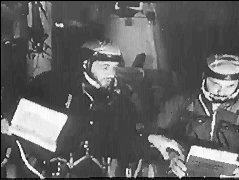



















![A trajectory analysis that used a computational fluid dynamics approach to determine the likely position and velocity histories of the foam (Credits: NASA Ref [1] p61).](https://www.spacesafetymagazine.com/wp-content/uploads/2014/05/fluid-dynamics-trajectory-analysis-50x50.jpg)



It is so awful when someone dies in space, nobody to help you, and very little to do to help yourself.